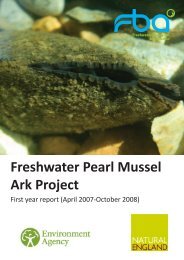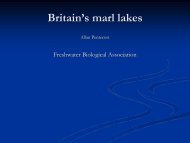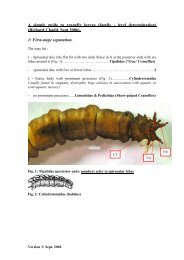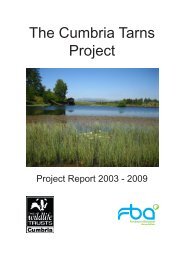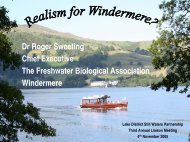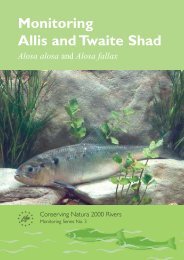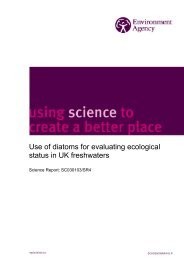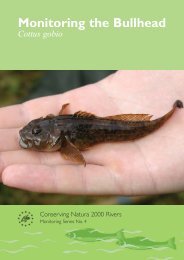EN REPORT (SCIE) F&B (3529b) - FreshwaterLife
EN REPORT (SCIE) F&B (3529b) - FreshwaterLife
EN REPORT (SCIE) F&B (3529b) - FreshwaterLife
You also want an ePaper? Increase the reach of your titles
YUMPU automatically turns print PDFs into web optimized ePapers that Google loves.
7.3 Pathway of introduction<br />
There are two major pathways of introduction (Table 6). The largest is accidental transport,<br />
which is strongly predominant for marine organisms and fungi and is also the major pathway<br />
for animals. Terrestrial and freshwater plants, on the other hand, are mostly escapes from<br />
cultivation. This result is well known. Crop plants and former crop plants are relatively few;<br />
the main source of alien plants is ornamental gardening (Crawley, Harvey & Purvis 1996). It<br />
is notable that no plants are signified as ‘released’, whereas this is a substantial pathway for<br />
animals, eg ornamental varieties of freshwater fish (Copp and others 2005b). Plants have<br />
frequently been planted or sown into the wild, but this is rarely used as a means of<br />
introduction. In Scotland, several non-native alpine plants such as Homogyne alpina were<br />
planted into the wild; some orchids have been introduced in this way to England but did not<br />
persist.<br />
There is a large predominance of vertebrates among deliberately released animals. Most of<br />
these were released by enthusiasts who would like to see their pets or potential quarry species<br />
established in the wild. There were also several reintroductions of formerly native species,<br />
among which the large blue Maculinea arion and red kite Milvus milvus have been notable<br />
successes. Successful introductions of biocontrol agents have been relatively few. The<br />
database lists the greenhouse mite Neoseiulus californicus, which occurs outdoors but is<br />
possibly not established there, the parasitic wasp Psyllaephagus pilosus used to control blue<br />
gum psyllid Ctenarytaina eucalypti, and Rhizophagus grandis, a predatory beetle introduced<br />
with great success to contol the great spruce bark beetle Dendroctonus micans.<br />
Table 6. Pathways of introduction in marine and terrestrial groups<br />
Code Pathway of introduction Marine Animals Plants Fungi &<br />
microbes<br />
Total<br />
D Dispersed from introduced pop. 8 2 10<br />
DT Dispersed and/or transported 2 1 3<br />
E Escape from captivity or cultiv. 21 424 445<br />
ER Escaped and/or released 34 1 35<br />
ET Escaped or transported 9 9<br />
H Hybrid - native x alien 13 13<br />
R Released - deliberate release 5 65 7 77<br />
RT Released and/or transported 2 2<br />
T Transported - accidentally 47 316 215 143 721<br />
U Unknown. 4 82 11 1 98<br />
Total 64 524 680 145 1413<br />
7.4 Continent of origin<br />
It is hardly a surprise that marine introductions mostly do not originate from Europe.<br />
European species can generally reach England by natural dispersal and would establish<br />
populations in suitable conditions. The one exception is Mytilicola intestinalis, a parasitic<br />
copepod introduced from the Mediterranean. At the other extreme, almost exactly two-thirds<br />
of plant species are of European origin. For terrestrial and freshwater species, North America<br />
is the next most frequent continent of origin, though for freshwater fishes an approximately<br />
equal number of species originate from North America and the European/Asian Continent. A<br />
special feature of plants is that 35 species are signified as having their origin in agriculture or<br />
horticulture. In principle, the same could be said (with obvious changes of wording) for feral<br />
24




